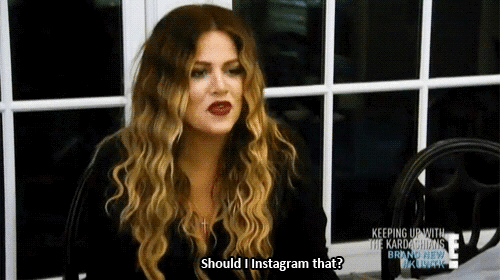
I will openly admit that I am incredibly casual when it comes to the maintenance of my personal social media accounts. Any funny thought that comes through my head that should be shared goes on Twitter; an interesting article that I feel others should see is shared straight to Facebook; any picture of someone doing something awkward is tacked onto my Snapchat story. These channels are just an extension of my personality and act as a way to share my thoughts with people who are not near me right at that moment. It’s my second voice.
I began to think about my personal practices a bit more after hanging out with one of my friends. We were hanging out in Schenley Plaza and she took a picture and was going to post it to Instagram when she stopped and said, “Oh never mind. I already posted to Instagram twice today.” To which I responded, “…so?” She explained that she believes that posting more than twice to Instagram in a day is excessive and annoying. I followed up with, “What makes it different from posting to Twitter more than twice?” which she does. The answer she gave? “It’s just different.”
So what makes multiple Instagram posts unacceptable, but not multiple tweets in a row when 140 characters are not enough? I scoured the Internet to try and find some rules and etiquette for how much posting is too much posting.

Carolyn Edgecomb from Impact Branding and Design shares a few of the factors that affect how frequently you should post and how long your post should be. It really depends on which social media site you are posting to: “With over 400 million tweets posted a day, your tweets can easily get lost among the noise. Which gives you the opportunity to post more frequently.” There is no limit to Twitter. She does further suggest that tweets are kept a little bit shorter than 140 characters to allow followers to share tweets without having to cut off a link or another part of the tweet.
When it comes to Instagram, you should limit yourself. According to the New York Daily News, a study was conducted which discovered that the more frequently a person posts an image to Instagram, the least likely their followers are to interact and ‘like’ the image. The study also found that selfies on Instagram are more likely to be liked: “In fact, if an image features a person’s face it is 38 percent more likely to be liked and 32 percent more likely to attract comments.” This explains why my friend has so many selfies on her Instagram roll!
After looking through these articles, I understand where my friend was coming from. The fact that these are pretty much settled upon rules fascinates me. I guess, now that I think about it, while I may not post to Instagram very frequently, when I do it never exceeds two pictures if I post that much at all.
How about you all? Do you set limits for yourself when it comes to posting to social media?
Great blog post! This is something that I think about a lot when posting on social media, especially since the beginning of the semester when this class began and started to see my social media platforms as more than a source of entertainment. I struggle with using Twitter because I rarely post, so my existence is slim-to-none, but on Instagram it is quite different because I have two accounts that are so different from one another and each have a distinct purpose. I do tend to over-post on Instagram, which is something that I am trying to work on, but I also think that it goes with its purpose so I am not too self-conscious about it. It would be interesting to see what the literature on the frequency of Facebook posting says.
LikeLike
This was a really good topic to touch on! I hadn’t given much thought to frequency of posts until taking this class. I definitely didn’t realize what you found out about Instagram, but it does kind of make sense. I would probably be annoyed if my feed was over-saturated with posts from one person because most people I follow only post once or twice a day. I wish I had known this info before doing our digital storytelling project!
LikeLike
I think this was a really interesting, relevant post. We have been discussing in class the different ways that we use different social media platforms, and I think this is an interesting idea to explore. There is actually a surprising amount of research done on Instagram and Twitter and the effectiveness of certain types of posting. I don’t remember exactly where I read this, but I found that there are certain times a day that an Instagram post will get more likes regardless of the content. The article I read said that the best time to post an Instagram picture is around 5 p.m. I tried the theory, and I’ve actually been surprised. The explanation is that most people are free around dinner time and are more likely to be scrolling through social media. I’ve recently noticed that I post pictures late at night. I have tried to avoid doing so, and have seen a rather steep increase in likes. I kind of resonate with your friend in that I try to not post more than two pictures a day. It seems superficial and like I’m trying too hard to show the world what I’m doing. On the other hand, I tweet anything that comes to mind. And on the other end of the spectrum, I only ever use Facebook anymore to send distant friends birthday wishes. It’s funny how we have a certain set of rules for ourselves in using our social media platforms. Very engaging post!
LikeLike
I love this post! I am always thinking about how much I’m posting to social media. For my work accounts I make sure to post regularly to keep my audience engaged but not too much so my post become over crowded. I have done series in the past on social media and have played around with the timing of posts. I have done month long series where I post once a day and then I have done series where I post the series in one day, which can be up to 15 posts. With the post one series in a day I have found that my engagement on Instagram is significantly lower. So I agree with your post and the studies that you found!
LikeLike
This is an interesting part of the web 2.0 world; the fact that there are rules that are understood (though you clearly found some articles with explicit rules) adds a whole new aspect to social etiquette. I definitely get annoyed when people go overboard with posting on Facebook or Instagram… especially Instagram, for some reason. To me, someone’s posts seem less note-worthy if they post a selfie of themselves every day. There are people who post multiple things but still get over one hundred likes every time though, so it works for some people! When it comes to professional organizations on social media, I think it’s important to not go overboard, especially if it’s promotional material that could lose its charm if overused. You want to be able to show people what’s going on in your life and that you’re staying up-to-date with everything else, but you don’t want to send the message as an organization that you’re sitting on Twitter all day instead of doing other work. Moderation is always key.
LikeLike
This is interesting about posting less on Instagram and more on Twitter. I just created an Instagram account this semester have only posted one pic. My assumption was that people posted many pics a day. Facebook is that same as Twitter where people are posting constantly. So why is Instagram different? Its mostly just pics whereas Twitter seems more of an informative social media platform. In my opinion if you over post pics of yourself on social media, it can be less interesting and less liked. Keeping proper etiquette on social media should be considered.
LikeLike
I think this post uses sources that I, and I think most people, agree with. From my own use of social media, I see no limit with Twitter. Whether it’s my original tweets or replies to other users, I use the platform multiple times each day. Now that conversations are strung along and displayed in a combined manner, it may seem as if I’m tweeting much more, when really, it’s a consistent conversation that may span more than a minute or hour.
LikeLike